Virginia Mills hails a new addition to the Royal Society archives: the correspondence and photographs of Nobel Prize winning animal behaviour expert Nikolaas Tinbergen FRS.
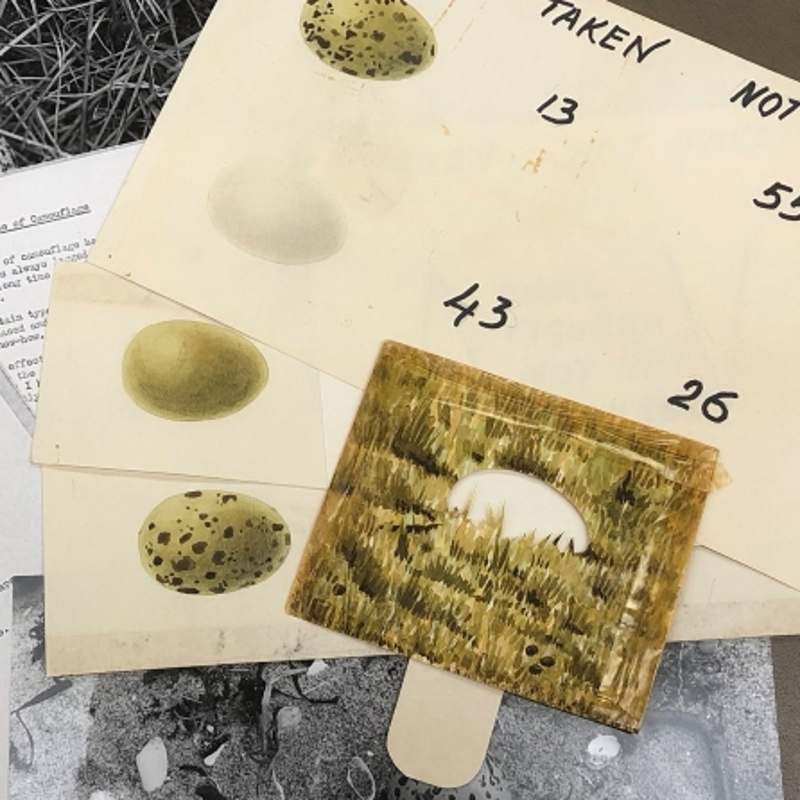
In January the Royal Society Archive received an exciting donation of the correspondence and photographs of a Nobel Prize winner – zoologist and biologist Nikolaas ‘Niko’ Tinbergen (1907-1988).
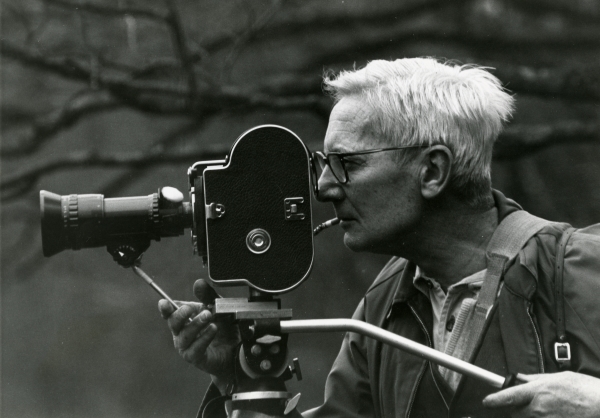
Portrait of Niko Tinbergen c.1970 [MS/924/1/1/001]
Tinbergen became a Fellow of the Royal Society in 1962 in recognition of his studies on animal behaviour or ‘ethology’, of which he is considered a founding father. He proved that there was virtue in what he called a ‘watching and wondering’ approach, and became known for developing the ‘four question framework’ as the proposed basis for all animal behaviour research (causation, development, function and evolution). The Nobel Prize came for his experiments designed to identify the characteristics to which animals were programmed to respond. He tested responses by introducing stimuli similar to those occurring naturally but with exaggerated features. A lurid polka dot egg for example proved to be more attractive to birds than their naturally pale speckled eggs. The papers deposited at the Royal Society show that Tinbergen was also researching the markings on eggs as an example of natural camouflage.
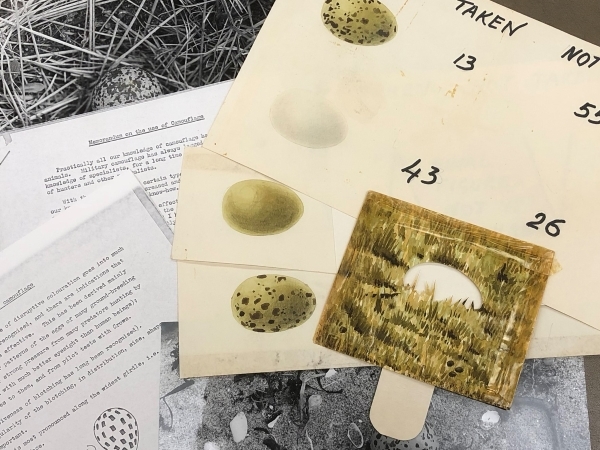 Photographs and watercolours of bird eggs with camouflage ‘viewer’, from Niko Tinbergen’s papers in the Royal Society Archive [MS/924/2/3]
Photographs and watercolours of bird eggs with camouflage ‘viewer’, from Niko Tinbergen’s papers in the Royal Society Archive [MS/924/2/3]
Originally from the Netherlands, Tinbergen did much of his pioneering work during a long career at the University of Oxford where he was a Fellow of Merton College and Wolfson College from 1949-1974, rising to the position of Professor of Zoology. This proved to be a golden age of ethology centred on the research group Tinbergen established at Oxford: the Animal Behaviour Research Group (ABRG). The photographs donated to the Royal Society date to this productive time in Tinbergen’s career and show a group that obviously enjoyed great fun and camaraderie while conducting their research. The photographs of Tinbergen and his researchers in the field, many at their research station in the nature reserve on Walney Island in Cumbria, show them both observing and interacting with bird life. The group would observe from state-of-the-art hides designed by Tinbergen and using long lens cameras, but also undertook taming of animals and kept two tame crows ‘Nikon’ and ’Rolleiflex’.
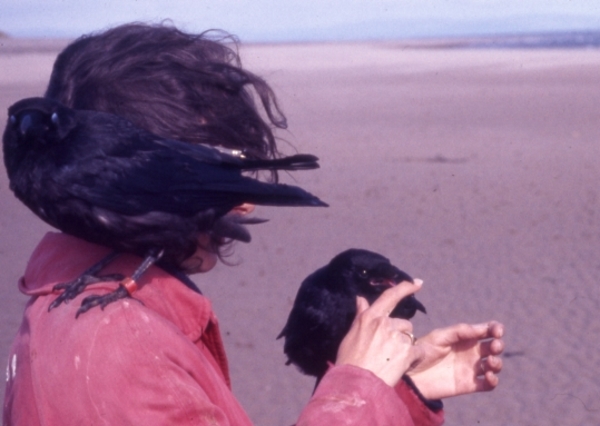
Researcher Barbara MacRoberts with ABRG pet crows Nikon and Rolleiflex, Walney Island Field Camp, 1969 [MS/924/1/2/75]
As the names of his pet crows hint, Tinbergen was very interested in the potential of photography and filming, both for his research and communicating science to the public. He considered wildlife photography a non-lethal form of hunting, allowing him to capture not just an animal but its surroundings and interaction with the environment. During the 1960s and 1970s he spent time making nature documentaries for the BBC and Yorkshire TV and was in the vanguard of film makers taking a storytelling approach to wildlife films, emphasising in his letters to his students that finding and honing the narrative arc is key. This accessible documentary style brought critical and popular success with films and books including Signals for Survival and Tracks made with producer/director Hugh Falkus. To see how enduring this approach has been, one need only look to recent wildlife programmes like Meerkat Manor, where it is taken to an extreme, the behaviour of a meerkat group being related over many episodes almost like a soap opera.
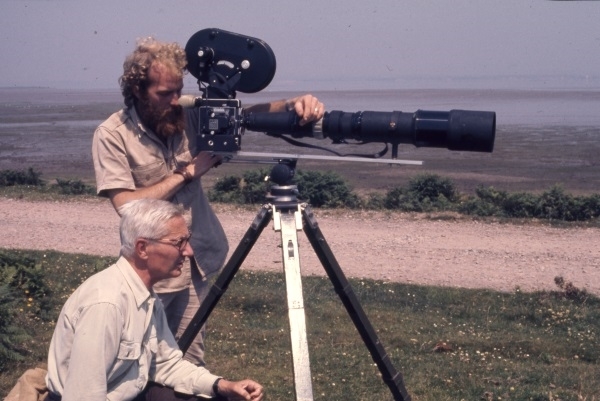
Niko Tinbergen filming on Walney beach with student and cameraman Lary Shaffer, Walney Island Field Camp, 1969 [MS/924/1/2/53]
It was Lary Shaffer, ex-student, cameraman and long-time correspondent of Tinbergen’s, who kindly donated the Tinbergen material to the Royal Society. Shaffer describes the group as being like a family. His collection of slides and photographs are fascinating for showing the research group not only at work but at play, enjoying bonfire night celebrations and clowning around at the research station.
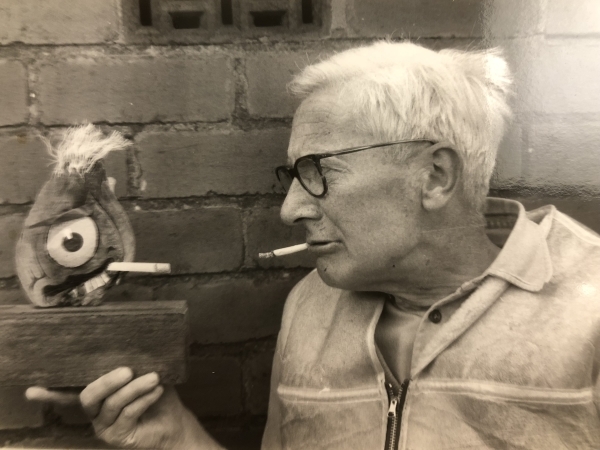
Tinbergen may have been the father of ethology but he was not above gurning with a driftwood self portrait [MS/924/1/1/002]
The correspondence donated to the Society is chiefly between Shaffer and Tinbergen and their wives, and the letters show a development from a professional and administrative tone when Shaffer joined the group in 1968 to an exchange between professional and personal confidants, covering their family lives as well as feedback on scientific endeavours and publications right up until Tinbergen’s death in 1988.
Other doctoral students who were part of the ABRG under Tinbergen went on to become renowned biologists, including John Krebs FRS, Peter Grant FRS, Jack Frazier, Mike Cullen, Desmond Morris, Iain Douglas-Hamilton, Marian Dawkins FRS and Richard Dawkins FRS and Tinbergen’s biographer Hans Kruuk, to name a few. These fellow researchers are frequently discussed in the Shaffer-Tinbergen correspondence, as you would expect in such a tight-knit group, and appear in Shaffer’s photographs.
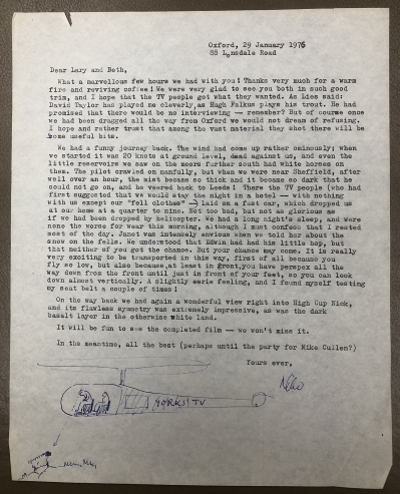
An illustrated letter from Tinbergen to Shaffer describing a helicopter flight while filming with Yorkshire TV, Oxford, 29 January 1976 [MS/924/2/10]
Shaffer left the group in 1976, bound for America, but his correspondence with Tinbergen continued as his mentor’s physical and mental health deteriorated and Tinbergen’s research focus shifted to transferring his observational and taming methods from animals to children with autism, a controversial approach now widely considered outdated. Overall the correspondence provides a fascinating insight into Tinbergen’s changing research interests over a period of twenty years. In his letters Tinbergen is also very frank and open about his personal life, opinions and state of mind. As some of the material in the letters is sensitive, the decision has been taken to keep the correspondence closed until next year, when a full 30 years will have elapsed since the great ethologist’s death. Some information is however available in our catalogue, and digital copies of all Shaffer’s slides and photographs of Tinbergen and the ABRG will soon be going up on the Royal Society Picture Library, so for now – in the spirit of Tinbergen – watch this space and wonder.

